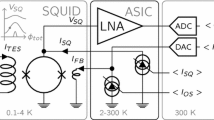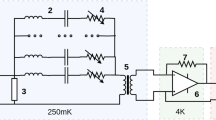Abstract
This paper updates the development of a warm front-end electronics (WFEE) dedicated to cryogenic sensors readout. It belongs to the X-ray integral field unit instrument of ESA’s future space observatory: ATHENA. This instrument integrates cryogenic elements such as 3168 transition edge sensors as detectors, multiplexed into 96 channels using time-division multiplexing (TDM). One TDM channel will be read out by two stages of superconducting quantum interference device (SQUID), followed by a WFEE and finally, a digital readout system, both two last stages operating at about 300 K. In the WFEE, 96 TDM channels will be distributed in 48 application-specific integrated circuits (ASIC). Each channel includes one low-noise amplifier to amplify the multiplexed signal and 5 configurable current sources to bias the SQUIDs and TES in the cryogenic stages. Additionally, two channels within the same ASIC share a serial bus “RS485/I\(^2\)C” to configure the current sources (current SlowDACs) and housekeeping elements that monitor the temperature, current and voltage of the ASIC. The ASIC presented in this paper, “AwaXe_v3” (AwaXe: Athena Warm Asic for the X-ifu Electronics), is developed for the WFEE using an AMS 350 nm SiGe BiCMOS technology. It is the first prototype of the WFEE integrating two complete TDM channels. Representative measurement results that characterise the main components of the WFEE will be discussed in this paper as an update on the use of ASIC for the TES/SQUID readout.





Similar content being viewed by others
Data Availability
The data that support the findings of this study are available from the corresponding author upon reasonable request.
Notes
Both \(R_{{\rm CTAT}}\) and \(R_\mathrm{PTAT}{}\) using two parallel resistors to achieve the desired values.
Due to chip dissipation, the ASIC operating temperature is expected, in vacuum, about 10 K above bath temperature 300 K, so around 37 \(^\circ \)C. This is the expected operating temperature in orbit, maintained by thermal regulation.
References
K. Nandra, D. Barret, et al. arXiv:1306.2307 (2013)
M. Collon, G. Vacanti, N. Barriere, B. Landgraf, et al., Proceeding ICSO 2018 (2019). https://doi.org/10.1117/12.2535994
D. Barret, T.L. Trong, Giorgi, et al., SPIE 2018: Ultraviolet to Gamma Ray (2018). https://doi.org/10.1117/12.2312409
N. Meidinger, S. Albrecht, C. Beitler, et al., SPIE 2020: Ultraviolet to Gamma Ray (2020). https://doi.org/10.1117/12.2560507
S. Chen, D. Prêle, B. Courty, F. Voisin, J. Mesquida, SPIE 2020: Ultraviolet to Gamma Ray (2020). https://doi.org/10.1117/12.2561072
D. Prêle, F. Voisin, C. Beillimaz, S. Chen, M. Piat, A. Goldwurm, P. Laurent, J. Low Temp. Phys. (2018). https://doi.org/10.1007/s10909-018-1886-3
D. Prêle, S. Chen, A. Coleiro, P. Varniere, P. Peille, L. Ravera, C. Kirsch, SPIE 2020: Ultraviolet to Gamma Ray (2020). https://doi.org/10.1117/12.2560367
B. Razavi (2001). ISBN 978-7-302-10886-3
M. Gonzalez, D. Prêle, S. Chen, Fully differential broadband LNA with active impedance matching for SQUID readout, J. Low Temp. Phys. This Special Issue (2021)
M. Durkin, J.S. Adams, S.R. Bandler et al., IEEE Trans. Appl. Supercond. (2019). https://doi.org/10.1109/TASC.2019.2904472
S. Chen, PhD Thesis (2019). HAL Id: tel-03004402
Funding
This work is supported by the Centre National de la Recherche Scientifique (CNRS) and the Centre National d’Etudes Spatiales (CNES) under the WFEE project. WFEE is a work package of the X-IFU instrument of the ATHENA European Space Agency (ESA) mission.
Author information
Authors and Affiliations
Corresponding author
Additional information
Publisher's Note
Springer Nature remains neutral with regard to jurisdictional claims in published maps and institutional affiliations.
Rights and permissions
Springer Nature or its licensor holds exclusive rights to this article under a publishing agreement with the author(s) or other rightsholder(s); author self-archiving of the accepted manuscript version of this article is solely governed by the terms of such publishing agreement and applicable law.
About this article
Cite this article
Chen, S., Prêle, D., Gonzalez, M. et al. Room Temperature ASIC for Cryogenic TES/SQUID Control and Readout. J Low Temp Phys 209, 614–621 (2022). https://doi.org/10.1007/s10909-022-02833-6
Received:
Accepted:
Published:
Issue Date:
DOI: https://doi.org/10.1007/s10909-022-02833-6




